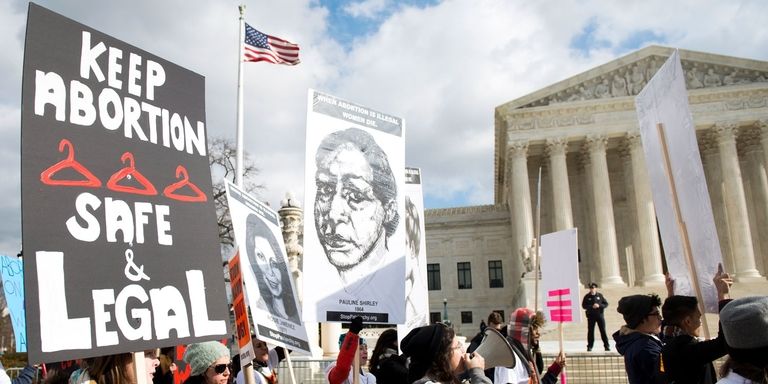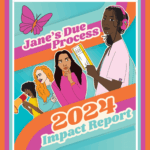Last month, the US House of Representatives passed a bill that would ban abortion after 20 weeks, barring cases of rape, incest, or danger to the mother’s life. Unconstitutional bans on abortion at or before 20 weeks post-fertilization are already in place in 17 U.S. states including Texas, directly contesting Americans’ constitutional right to abortion. This most recent bill is yet another attempt in a long-running endeavor to undermine Roe v. Wade, which legalized abortion in 1973.
While very few – barely over 1% – of abortions in the U.S. take place after 20 weeks of pregnancy, there are several factors that could result in a second trimester abortion. Anyone who can become pregnant could potentially be affected by these bans. Those seeking later abortions often have trouble physically getting to a provider, finding the money to cover the procedure or travel to the clinic, or often just don’t realize they’re pregnant until their pregnancy is further along. Still more have wanted pregnancies that they need to terminate for health reasons – situations that become legally complicated and life-threatening in states that only allow abortions after 20 weeks if the mother’s life is already in danger.
Geographic barriers and clinic shortages
89% of U.S. counties lack any kind of abortion provider. In many states, most hospitals don’t offer abortions because so many of them are Catholic, or because the restrictive laws around abortion and funding for abortion result in abortion providers being isolated from other medical providers and forced into separate clinics. This makes finding a clinic that will perform an abortion extremely difficult, forcing 19% of U.S. women to travel 50 to 100 miles for their procedure.
In Texas, this extra hurdle proves especially challenging considering the mandated 24-hour wait period to receive an abortion, requiring women to travel to not one but two appointments, both within a day of each other. This mandate also requires the same doctor who performed the ultrasound to perform the abortion, which causes another hurdle as many doctors fly in from other cities or states. So, if Doctor X performs the ultrasound on Thursday, but then can’t get back to the clinic until Tuesday when Doctor Y is scheduled, Doctor Y would have to perform another ultrasound and another 24-hour waiting period would start.
Financial hurdles
Abortion isn’t cheap. Nationally, the average cost for an abortion is close to $500 in the first trimester, with prices then increasing to around $850 in the second trimester. Without insurance coverage — and without Medicaid coverage due to the Hyde Amendment’s ban on federal funding of abortion — this is a hefty fee. As of this year, a new law requires Texas women to pay an additional premium for their insurance plans to cover abortion — an event no one plans ahead for.
For many, it takes time to raise enough money to be able to afford the procedure, pushing the abortion farther down the road. Beyond the cost of the abortion itself, those traveling long distances also have to come up with the funds to cover their trip to the clinic. As a result, women at or under 100% of the poverty level are more likely to have a second trimester abortion that more well-off women, which creates a vicious cycle: after the first trimester, non-hospital abortion are much more expensive, with the average abortion at 20 weeks costing $1,500. In Texas, where abortion clinics face additional restrictions that increase costs, or if a pregnant person is experiencing complications, that price can easily skyrocket to many thousands of dollars.
Medical barriers
Beyond financial and geographic barriers, the decision to get a second trimester abortion can also be impacted by medical and health related issues. In these cases, women cited potential fetal anomaly, histories of miscarriage, use of prescription or non-prescription substances, or lack of prenatal care. If using birth control, some pregnancy symptoms can also go unnoticed, delaying the pregnancy further. Many people using IUD’s or birth control pills don’t have regular periods, making it easy to write off a late period as a normal side effect of birth control. Many states with 20-week bans have exceptions for the life of the mother, but this puts people experiencing pregnancy complications in a precarious state. For example, if someone who is 24-weeks pregnant has a fetus with severe abnormalities incompatible with life, and her water breaks, she is at risk for sepsis, preeclampsia, and other life-threatening complications. But the hospital may not be legally allowed to induce her until the fetal heart tone ends, or until she goes into septic shock. With 20-week bans, an abortion cannot be used to prevent a life-threatening condition – only to treat one once it starts occurring, at great risk to the pregnant person.
Legal barriers
Several legal barriers can slow down the abortion process, including incarceration and immigration hurdles. As we recently witnessed in Jane Doe’s horrifying battle with the U.S. government to have an abortion she had already been legally granted, immigration status and detention play huge roles in the timeline of abortions, often causing lengthy and exhausting delays.
Change of circumstances
A lot can change in the first few months of pregnancy. Losing a partner, job or another form of support can quickly change a wanted pregnancy into an unwanted one.
- Violence or absence of their partner.
- Partner’s lack of emotional or financial support.
- Denial of pregnancy, often as a result of rape or incest.
- Many more – there are as many reasons for choosing an abortion as there are abortions.
The 20-week ban’s effect on teens
Teens could be most affected by a ban on abortion after twenty weeks. In 37 states, teens are obligated to get parental consent to end their pregnancy, or receive a judicial bypass. On top of the extra hurdles and hardships teen must face in such a challenging time in their lives, teens often confirm their pregnancies later than adults. This is sometimes due to an irregular period as their bodies develop a consistent cycle, fear or anxiety about what might happen once they find out, or denial. Or, it can be due to their state’s lack of comprehensive sex education – as a result of strict laws on abortion clinics or abstinence-only education in schools – leaving them less in touch with their bodies or confused about how pregnancy occurs in the first place.
Because of the extra hurdles teens under 18 face to receive an abortion — most obnoxiously, judicial bypass — their timeframe to get an abortion shrinks. The 20-week ban pushes them up against a hard deadline made even more challenging in such a confusing, stressful time.
These bans hurt us all.
As of 1973, we have a constitutional right to abortion in this country, up to viability — well into the second trimester and certainly past 20 weeks. New restrictions — especially the recently proposed national ban on abortion after 20 weeks — are schemes to strip us of our bodily autonomy, and chip away at Roe v. Wade. There are many reasons someone might need an abortion after 20 weeks, all of them valid and none up for public debate.




